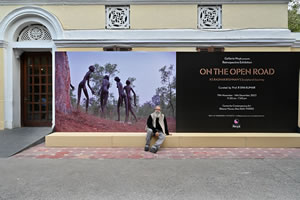
Girish Shahane
Riding on an Invisible Black Horse :Colaba Art District
Pundole Gallery at Flora Fountain in the north, and Sakshi and Lakeeren at Arthur Bunder Road, the ‘Arab Quarter’ of Colaba in the south, Mumbai’s ‘Art District’ oscillates between Kala Ghoda and Colaba. This art hub has seen the ups and downs of art market. Girish Shahane pens down its concise history and hopes that sooner than later it would
regain its lost glory. art precinct some fifteen years ago, soon after the NGMA’s inaugural show at the renovated Cowasji Jehangir Hall. The Kala Ghoda Association, which had focused on restoring 19th and early 20th century buildings in the area, proposed an annual festival on Rampart Row to underline the locality’s art connection while also drawing attention to its built heritage. Jehangir Art Gallery, Gallery Chemould, the Artists’ Centre and the Max Mueller Bhavan stood within Kala Ghoda proper, but the definition of the art district was more lax, spreading from Pundole Gallery near Flora Fountain in the north, to Sakshi gallery in Colaba to the south.
Through the early years of the twenty-first century, the connection between Kala Ghoda and art grew stronger, with galleries like Bodhi and Vikram Sethi’s ICIA being established on Rampart Row. In February 2007, Bodhi sponsored elaborate installations by Nataraj Sharma and N. S. Harsha during the Kala Ghoda Arts Festival. By then, however, the city’s art gallery hub had begun shifting to Colaba. Galleries started opening on Arthur Bunder Road, in what I used to jokingly call the city’s Arab quarter because of the throngs of desert-dwellers who came to stay in hotels on that street, particularly during the monsoon months when they hoped to catch sight of torrents of rain of an intensity never witnessed in their homelands. Arthur Bunder Road’s gentrification had commenced before Chatterjee & Lal moved to Kamal Mansion from a cramped space near Regal Circle, but the introduction of cutting-edge art to the neighbourhood speeded up the process. Gallery Maskara and Project 88, meanwhile, took over heritage properties further south.
When Gallery Chemould moved out of the Jehangir Art Gallery building to a large space near Sterling Cinema, and Bodhi closed in the wake of the meltdown, Kala Ghoda stopped being a must-visit location for art enthusiasts. The Kala Ghoda Arts Festival more or less severed connections with galleries in the area, and built its own visual arts programme. Many of the newer galleries were hard to locate, being situated on the first or second floor of properties. Only people really interested in art would take the trouble to find them, whereas, in the past, galleries like Pundole and Bodhi had ground floor entrances on roads with plenty of pedestrian traffic, and could therefore attract passersby. Once dealers stopped thinking of the post-meltdown phase as a recession, and started Private galleries are the heart of Bombay’s art world.
The National Gallery of Modern Art, and the relatively new Jehangir Nicholson gallery at the CSMVS museum have the
occasional interesting show. The Bhau Daji Lad museum in Lalbaug near the center of the island city has mounted
some of the best displays of the past four years. However, the bulk of the heavy lifting is done by galleries, most of
which operate in the south of the city.
An area called Kala Ghoda, named for an equestrian statue of King Edward VII that used to stand at the centre of
what is now a triangular traffic island, was branded the city’s

